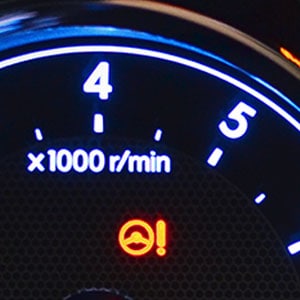Imagine driving down the road, music playing, everything seems perfect, and then, out of nowhere, a mysterious symbol lights up on your dashboard: the steering wheel light. It’s a moment that can cause a jolt of anxiety.
What does it mean? Should you pull over immediately, or can it wait until later? This tiny light could be trying to tell you something important about your vehicle’s health, and knowing what it means could save you from unexpected hassles.
In this post, you’ll discover exactly what this light is signaling, ensuring you’re not left in the dark the next time it illuminates. Let’s unravel this mystery together and bring peace of mind back to your drive.

Credit: nortexlubeandtune.com
Dashboard Warning Lights
Seeing a steering wheel light on your dashboard indicates a potential issue with your vehicle’s steering system. It may suggest low power steering fluid or a malfunction in the electronic power steering. Addressing this promptly ensures safe driving and prevents further complications.
Understanding dashboard warning lights can save you from unexpected car troubles. These lights act as your car’s way of communicating issues. Knowing what each symbol means can help you address problems quickly and efficiently. ###Common Symbols
When you see the steering wheel light on your dashboard, it can be confusing. This symbol often indicates a problem with your power steering system. It might look like a steering wheel with an exclamation mark. But what does it really mean for your vehicle? Take a moment to think about the last time you had a dashboard warning light pop up. Did you know what it meant? Identifying common symbols can help you respond appropriately without panicking. ###Color Indicators
The color of the warning light matters. A red light usually means you need to take immediate action. It’s like your car is shouting for help. On the other hand, a yellow or orange light suggests caution but isn’t as urgent. Imagine driving and suddenly a red steering wheel light appears. It’s crucial to pull over safely and check your vehicle or consult a professional. Ignoring it could lead to more severe issues, affecting your car’s safety and performance. Consider your own vehicle. Do you know what color each warning light is? Familiarizing yourself with these indicators can prevent small issues from becoming big problems. By understanding these symbols and colors, you become more in tune with your vehicle. This knowledge not only helps in maintaining your car but also ensures your safety on the road. Are you prepared to interpret these signals the next time they appear?
Credit: www.goodyearautoservice.com
Steering Wheel Light Symbol
Understanding car symbols can be confusing, especially the steering wheel light. This symbol plays a vital role in your vehicle’s safety. It indicates issues related to steering or power steering systems.
Appearance And Location
The steering wheel light symbol often resembles a steering wheel or an exclamation mark. You usually find it on the dashboard, near other important indicators. It lights up when the vehicle’s computer detects an issue.
Its color can vary, often seen in red or yellow. A red light signals urgent problems. A yellow light suggests caution, but not immediate danger. Knowing these differences helps in responding appropriately.
Variations Across Models
The steering wheel light symbol varies across car models. Some cars may display an exclamation mark within a steering wheel symbol. Others might use different shapes or colors.
In luxury models, the symbol might come with additional messages. These messages provide more details about the issue. Check your car manual for specifics about your model.
Understanding these differences helps in identifying problems quickly. This knowledge ensures timely maintenance and safe driving.
Causes Of Steering Wheel Light
The steering wheel light is not just a decoration on your dashboard. It’s a critical signal that something may be wrong with your vehicle’s steering system. Understanding the causes behind this warning can save you from unexpected breakdowns or costly repairs. Have you ever been driving and suddenly this light pops up? It’s a moment that can make your heart skip a beat. Let’s break down the possible causes.
Electrical Issues
One common cause of the steering wheel light is electrical issues. This could be due to a blown fuse or a faulty wiring connection. Imagine driving on a rainy night and your electrical system starts acting up. You might find your steering wheel feeling harder to maneuver.
Checking the fuses and ensuring all wires are intact can often resolve these issues. Have you ever considered how a small electrical glitch can impact your steering? It’s worth checking under the hood.
Power Steering Problems
Problems with the power steering system are another reason the steering wheel light may illuminate. This could be due to low power steering fluid or a malfunctioning pump. Picture yourself in the middle of a busy intersection and suddenly, turning the wheel becomes a workout. Not ideal, right?
Regularly checking and topping off your power steering fluid can prevent such situations. Your driving experience should be smooth, not a struggle. Is your steering wheel giving you more resistance than usual? It might be time for a fluid check.
Sensor Malfunctions
Sensor malfunctions can also trigger the steering wheel light. These sensors track the position and movement of the steering wheel. If they fail, the light alerts you to potential issues. Have you ever thought about how many sensors are keeping your car running smoothly?
Sometimes, a simple reset or recalibration can fix sensor issues. Keeping sensors in top shape ensures accurate steering feedback. Could a sensor glitch be affecting your steering performance? It’s a possibility worth exploring.
Understanding these causes can help you address the steering wheel light promptly. Next time you see it, you’ll know exactly where to start looking. This knowledge can keep you safe and your car in optimal condition. So, what steps will you take to keep your steering system in check?

Credit: www.fastlaneeuropean.com
Immediate Actions To Take
Seeing the steering wheel light on your dashboard can be unsettling. It’s not just a flicker of illumination; it’s a call for immediate action. Ignoring it could lead to safety hazards, and you wouldn’t want to risk your well-being or that of your passengers. So, what should you do when this light appears?
Safety Precautions
First and foremost, ensure your safety and that of everyone in the vehicle. Pull over to a safe location if you’re driving. You don’t want to compromise control, especially if you suspect a steering issue. Is there a safe area nearby where you can stop without obstructing traffic?
Once parked, turn off the engine and engage the parking brake. This prevents any unexpected movement and gives you a moment to assess the situation. Think of it as your first step in troubleshooting. Is your steering wheel harder to turn or making unusual noises?
When To Seek Professional Help
After taking safety precautions, evaluate the severity of the situation. Is the steering wheel completely unresponsive or does it feel different than usual? If you notice anything unusual, it’s time to consult a professional. Don’t wait for a minor issue to become a major problem.
If you’re unsure, err on the side of caution. Contact a certified mechanic or your vehicle’s service center. Describe the symptoms accurately. Would you risk driving with uncertainty, or prefer peace of mind knowing your car is in expert hands?
Remember, expert eyes can often spot issues that are invisible to the untrained eye. Have you ever thought about the expertise that goes into diagnosing automotive problems? The right help can prevent costly repairs down the road.
Taking prompt action when the steering wheel light is on not only ensures your safety but also preserves the longevity of your vehicle. What steps will you take the next time you see an unfamiliar light on your dashboard?
Importance Of Regular Maintenance
Understanding your car’s steering wheel light is crucial, but so is regular maintenance. Why? Because regular upkeep not only saves you from unexpected breakdowns but also extends the lifespan of your vehicle. Think of maintenance as your car’s way of staying healthy. Just like you wouldn’t skip your annual health check-up, don’t ignore your car’s needs. Let’s dive into how regular maintenance can make a difference.
Preventive Measures
Preventive measures are your first line of defense against potential car troubles. By addressing small issues before they become big problems, you safeguard your vehicle’s performance. Remember that time when your friend ignored a minor issue, only for it to snowball into a hefty repair bill? Don’t let that be you. Simple actions like checking fluid levels or tire pressure regularly can prevent costly repairs down the road.
Moreover, preventive maintenance can save you from the inconvenience of being stranded. Imagine you’re driving on a lonely highway, and suddenly, your steering wheel light turns on. Panic sets in. What if you had caught that issue during a routine check? You’d be cruising smoothly instead.
Routine Checks
Routine checks are as essential as your morning coffee. They keep everything running smoothly. By scheduling regular inspections, you ensure that every component of your car is functioning as it should. Think of it like a routine doctor’s visit for your car. These checks can spot potential issues before they escalate.
Consider creating a checklist for your routine checks. Include items like brake inspections, oil changes, and steering system evaluations. Regularly ticking off these boxes ensures you’re on top of your car’s health. Wondering how often you should conduct these checks? Depending on your driving habits, every few months is a good rule of thumb.
Imagine the peace of mind you’d have knowing your car is in tip-top shape. Regular maintenance isn’t just a chore; it’s your ticket to hassle-free driving. So, when was the last time you gave your car a thorough check-up? Maybe it’s time to roll up your sleeves and get started!
Potential Risks Of Ignoring The Light
Ignoring the steering wheel light can lead to serious issues. This light is an essential warning sign. It indicates potential problems with your vehicle’s steering system. Overlooking it can have significant consequences. Let’s delve into the potential risks associated with ignoring this crucial warning light.
Impact On Vehicle Handling
Ignoring the steering wheel light affects vehicle handling. Steering may become unpredictable. This can compromise your control over the car. Poor steering increases the risk of accidents. Safety on the road is jeopardized. Reliable steering is vital for safe driving. Addressing the issue ensures better vehicle control.
Long-term Damage
Continued neglect can lead to long-term damage. The steering system may suffer irreversible harm. Repair costs could escalate significantly. Parts may wear out faster. This reduces the lifespan of your vehicle. Regular maintenance prevents extensive damage. It preserves the health of your car’s steering system.
Cost Considerations
Understanding the steering wheel light can save you time and money. It signals potential issues with the steering system. Ignoring it can lead to costly repairs. Knowing the costs involved helps in planning and decision-making. Let’s explore what you might expect financially.
Repair Costs
Repairing a steering wheel issue varies widely in cost. Minor fixes could cost around $100. Major repairs might reach $1,000 or more. The exact cost depends on the problem’s complexity. Labor charges and parts needed also affect the price. Always get a detailed estimate from a trusted mechanic.
Warranty And Insurance Options
Check if your vehicle is still under warranty. Warranties can cover some or all repair costs. This depends on the issue and warranty terms. Review your insurance policy too. Some policies may cover steering system repairs. Knowing your coverage can prevent unexpected expenses.
Conclusion
Understanding the steering wheel light is important for car safety. It alerts you to potential issues with steering. Regular checks can prevent serious problems. If the light appears, it’s wise to act quickly. This ensures smooth and safe driving. Ignoring it can lead to costly repairs.
Always consult your car manual for guidance. Stay informed and drive safely. Your vehicle relies on you. So, keep an eye on dashboard lights. They communicate vital car information. Protect your car and yourself by paying attention. It’s a small step that makes a big difference.
